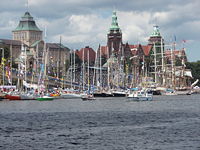Union of the Baltic Cities
- Union of the Baltic Cities
-
Die Union der Ostseestädte (englisch Union of the Baltic Cities) ist eine Vereinigung von derzeit 107 Städten der zehn Ostseeanrainerstaaten. Sie dient als dezentrales Netzwerk der grenzüberschreitenden kommunalen Zusammenarbeit im Ostseeraum.
Die Union der Ostseestädte (UBC) wurde im September 1991 in Danzig (polnisch Gdańsk), nach dem Fall des Eisernen Vorhangs, durch 32 Städte des Ostseeraums ins Leben gerufen. Die Grundlage der Kooperation ist die Verpflichtung zu einer gemeinsamen Entwicklung von Demokratie, Wirtschaft, Sozialwesen, Kultur und Umweltschutz in den jeweiligen Mitgliedsstädten.[1]
Höchstes Organ der UBC ist die Generalkonferenz. Sie tritt alle zwei Jahre in einer Mitgliedsstadt zusammen. Die Generalkonferenz wählt einen Exekutivrat, dem jeweils eine Stadt aus jedem Ostseeland angehört. Neben dem Exekutivrat besteht der UBC aus 13 Ausschüssen.[2]
Die Generalversammlung wählt den Präsidenten der UBC. Er wird von drei Vizepräsidenten und einem Sekretariat unterstützt. Der Sitz des Sekretariats ist Danzig. Derzeitiger Präsident der UBC ist Per Bødker Andersen, der von 1985 bis 2009 Bürgermeister des dänischen Kolding war.
Mitgliedsstädte
Kursiv geschrieben Städte waren Hansestädte.
Weblinks
Einzelnachweise
- ↑ http://www.ubc.net/about.html
- ↑ http://www.ubc.net/organisation/organisation.html
Wikimedia Foundation.
Schlagen Sie auch in anderen Wörterbüchern nach:
Occupation of the Baltic states — Part of a series of articles on the Occupation and annexation of the Baltic states … Wikipedia
Baltic Sea — Ostsee mit Anrainerstaaten und Inseln Die Ostsee (auch Baltisches Meer genannt, von lat. Mare Balticum und suevisches Meer nach dem Stamm der Sueben im heutigen Mecklenburg) ist ein 413.000 km² großes und bis zu 459 m tiefes Binnenmeer in Europa… … Deutsch Wikipedia
Union der Ostseestädte — Die Union der Ostseestädte (englisch Union of the Baltic Cities) ist eine Vereinigung von derzeit 107 Städten der zehn Ostseeanrainerstaaten. Sie dient als dezentrales Netzwerk der grenzüberschreitenden kommunalen Zusammenarbeit im Ostseeraum.… … Deutsch Wikipedia
Territorial changes of the Baltic states — refers to the redrawing of borders of Lithuania, Latvia and Estonia after 1940. The three republics, formerly autonomous regions ruled by the Baltic German nobility within the former Russian Empire, gained independence in the aftermath of World… … Wikipedia
Baltic Russians — The term Baltic Russians is usually used to refer to the Russian speaking communities in the Baltic states: Estonia, Latvia, and Lithuania.The term Baltic Russians does not imply a separate ethnic subcategory among the Russians. It came into use… … Wikipedia
Baltic Germans — The Baltic Germans ( de. Deutschbalten, or Baltendeutsche ) were mostly ethnically German inhabitants of the eastern shore of the Baltic Sea, which today form the countries of Estonia and Latvia. They formed, the social, commercial, political and … Wikipedia
The Thirty Years War — The Thirty Years War † Catholic Encyclopedia ► The Thirty Years War The Thirty Years War (1618 48), though pre eminently a German war, was also of great importance for the history of the whole of Europe, not only because nearly all… … Catholic encyclopedia
Baltic Way — (also Baltic chain, et. Balti kett, lv. Baltijas ceļš, lt. Baltijos kelias) is the event which occurred on August 23, 1989 when approximately two million people joined their hands to form an over 600 kilometer (373 mi) long human chain across the … Wikipedia
The Russian Campaign — is a strategic board wargame of the Eastern Front during World War II, during the period 1941 45. The unit scale is German Corps and Russian Armies. The game was designed by John Edwards, and was first published by Jedko Games in 1975. The Avalon … Wikipedia
Baltic Sea Region Programme — The Baltic Sea Region Programme 2007 2013 ( alias INTERREG IV B programme for the Baltic Sea region) is a support programme part financed by the European Union and Norway. It is one of the mainstream Structural Funds programmes under the European … Wikipedia

